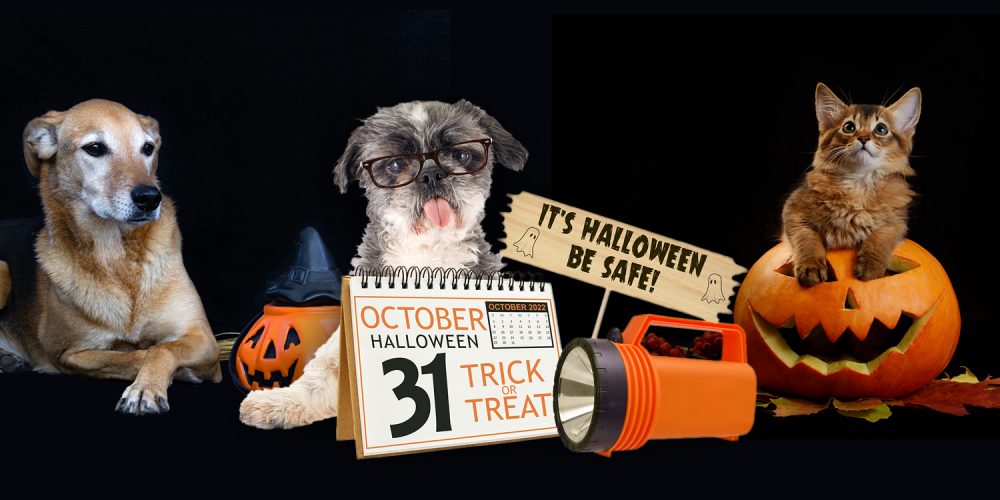
Halloween is a favorite holiday for many people, but not necessarily for pets. Spooky decorations, elaborate costumes, trick-or-treaters at the door, and costume parades can be fun for kids and adults. But be aware that Halloween activities can be frightening – and sometimes dangerous – for our pets that might not share their humans’ enthusiasm for the occasion.
Here are some suggestions to help keep your pets safe this Halloween.
Keep treats away from pets.
Make sure your bowls of candy and other treats are safely out of reach from your pets. Chocolate —especially dark chocolate—is toxic for cats and dogs. Sugar-free candies that contain xylitol, a sugar substitute, also can cause serious health problems for pets. Keep your stash away from your pets. And if you have children, make sure they’re aware of the dangers of sharing their treats with pets.
If you suspect your pet has eaten something toxic, immediately seek medical attention. If you’re not certain what to do, immediately call the ASPCA Poison Control Center at (888) 426-4435.
Keep an eye on decorations and electrical wires.
A curious pet can give your lit Jack-o-lantern a tumble and start a fire or get burned by candle flame. And while pumpkins and decorative corn aren’t considered toxic to pets, they can cause stomach upset if they are ingested. As for electrical wires, they should always be kept safely away from all pets, especially rabbits and other critters who like to nibble.
Costumes aren’t for every pet.
Dressing up pets in fun costumes and participating in pet costume contests and parades has become extremely popular. But not every pet wants to be dressed up like a weenie or fairy princess. For some pets, donning a costume can create stress, or even panic.
If you plan to dress up your pet, make sure he or she is comfortable with the costume, and doesn’t exhibit signs of anxiety or fear. Signs of discomfort can include a tucked tail, hunching over, ears folded down, or darting eyes.
Make sure the costume doesn’t interfere with your pet’s ability to move, see clearly, or breathe comfortably – the same precautions you would take for dressing up a child. Make sure the costume doesn’t include items that your pet can chew or could cause them to choke. It’s always a good idea to give your costumed pet a trial run ahead of the big event. If she shows signs of distress or resistance, it’s best to nix the costume and substitute a festive collar or bandana.
Neither are costume parades.
Unless your dog is comfortable with crowds and noise, skip the parade. Stay home and watch a spooky movie together, and snap a great selfie or family photo of you and your buddy enjoying healthy Halloween treats.
Make sure your home is a safe place for your pet.
Be sure all of your pets are indoors before nightfall on Halloween so they don’t run off when trick-or-treaters hit the streets. (Cats are always safest inside your home, regardless of what day it is.)
Trick-or-treaters or other guests arriving at your door can make any pet feel anxious, fearful, and protective. It’s a good idea to keep your pets in a calm, familiar space within your home, away from unfamiliar visitors, new sounds, and open doors that might allow them to escape. If your pets are used to being crated and consider their crate “safe space,” let them retire to their crate for the evening. The Humane Society of the United States (HSUS) suggests creating a “haunted house” out of cardboard boxes for your cat. She can stay safely snuggled in until the evening’s activities taper off. Even if your Halloween guests are familiar to your pets, remember that masks and costumes can make them appear unfamiliar – evening frightening – and react unpredictably.
Make sure your pets are microchipped and wearing ID tags. Be sure microchips are registered with your most current information and that ID tags feature your phone number. If you pet should escape through an open door, your chances of being reunited with them are greatly improved.
Halloween can be a fun holiday to share with your pets. Just make sure you’re celebrating with them sensibly and safely to keep them out of harm’s way. We invite you to follow us regularly on Facebook and Twitter for more pet-related information and updates.


